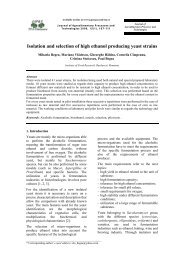Rapid methods for monitoring the microbiological quality of raw milk
Rapid methods for monitoring the microbiological quality of raw milk
Rapid methods for monitoring the microbiological quality of raw milk
You also want an ePaper? Increase the reach of your titles
YUMPU automatically turns print PDFs into web optimized ePapers that Google loves.
A. Căpriţă et al ./ Journal <strong>of</strong> Agroalimentary Processes and Technologies 14 (2008)bacteria counts in <strong>the</strong> past several decades,including ATP estimations (Niza-Ribeiro etal., 2000), direct epifluorescent filtertechnique (Rosmini et al., 2004) andelectrical <strong>methods</strong> (Yang et al., 2004;Felice et al., 1999). The ATP method andepifluorescent filter method are fast butcomplicated.Electrical <strong>methods</strong> are simple but requirean expensive instrument. Impedancemicrobiology (Firstenberg-Eden, 1984)was one <strong>of</strong> <strong>the</strong> earliest electrical <strong>methods</strong><strong>for</strong> <strong>the</strong> detection <strong>of</strong> bacteria in foods, andhas been developed as a rapid method thatcan detect bacteria within 24 h (Silley,1996). It is based on <strong>the</strong> measurement <strong>of</strong>changes in electrical impedance <strong>of</strong> amedium or a reaction solution resultingfrom <strong>the</strong> growth <strong>of</strong> bacteria. The majority<strong>of</strong> previous studies on <strong>the</strong> determination <strong>of</strong>bacterial counts have focused on <strong>the</strong>modification <strong>of</strong> <strong>the</strong> medium, aiming at <strong>the</strong>optimization <strong>of</strong> <strong>the</strong> electrical signals(Easter, 1985) or supporting <strong>the</strong> selectivegrowth <strong>of</strong> target bacteria against o<strong>the</strong>rbacteria. The impedance method wasapproved as an <strong>of</strong>ficial method <strong>for</strong> <strong>the</strong>detection <strong>of</strong> Salmonella in foods by <strong>the</strong>Association <strong>of</strong> Analytical Communities(AOAC) (Yang et al., 2004). Recentstudies have focused on <strong>the</strong> separatemeasurements <strong>of</strong> impedance change in <strong>the</strong>electrode and medium components <strong>for</strong> <strong>the</strong>rapid detection <strong>of</strong> bacteria in foods (Yanget al., 2004; Ong et al., 2001) known asimpedance-splitting (IS) <strong>methods</strong>. Felice etal. (1999) reported an IS method based on<strong>the</strong> measurement <strong>of</strong> <strong>the</strong> change in <strong>the</strong>electrode interface capacitance duringbacteria growth <strong>for</strong> <strong>the</strong> quantification <strong>of</strong>bacteria in <strong>milk</strong>.Conventional conductivity and impedancemeasurement techniques have proved to beuseful <strong>for</strong> bacteria counting in commercialapplications (Felice et al., 1999; Silley,1996). Devices based on <strong>the</strong>se techniquesmonitor microbial metabolism in a growthmedium by immersing electrodes directlyinto <strong>the</strong> medium and measuring <strong>the</strong>permittivity and/or conductivity (Ong etal., 2001).Despite <strong>the</strong>ir widespread application, <strong>the</strong>setechniques have many disadvantagesincluding polarization <strong>of</strong> <strong>the</strong> probeelectrodes, decreased sensitivity <strong>of</strong> <strong>the</strong>device in more conductive media and <strong>the</strong>high cost <strong>of</strong> instruments used.Adenosine Tri-Phosphate (ATP) is <strong>the</strong>most popular biochemical index as it isubiquitous in cellular life <strong>for</strong>ms and can bedetected rapidly using bioluminescencereactions. Bioluminescence is <strong>the</strong> emission<strong>of</strong> light by biological <strong>methods</strong> usingLuciferase enzyme (Griffiths, 1993).Luciferase, toge<strong>the</strong>r with its co-factors D-Luciferin and oxygen, produces light in <strong>the</strong>presence <strong>of</strong> ATP according to <strong>the</strong> followingreaction:Luciferase + D-Luciferin + O 2 + ATP → Luciferase+ oxy-luciferin + CO 2 + + AMP + PPi + LightThe amount <strong>of</strong> light is proportional to <strong>the</strong>concentration <strong>of</strong> ATP in <strong>the</strong> originalsample. The ATP concentration in a sampleis, in turn, related to <strong>the</strong> number and types<strong>of</strong> organisms within <strong>the</strong> sample. Thus arelative index <strong>of</strong> <strong>the</strong> amount <strong>of</strong>contamination can be generated usingfirefly bioluminescence within a fewminutes <strong>of</strong> sampling. O<strong>the</strong>r chemicals canbe used to index <strong>the</strong> levels <strong>of</strong> microbialcontamination in addition to ATP.3. Material and <strong>methods</strong>The experiments were carried out on <strong>milk</strong>samples d<strong>raw</strong>n from 12 dairy cows.The electrical conductance <strong>of</strong> <strong>the</strong> <strong>milk</strong>samples was measured with conductivitymeter type OK-102/1 (Radelkis).The instrument was standardized with KClsolutions <strong>of</strong> known conductance be<strong>for</strong>e use.The cell was washed with 0.01 M KClfollowed by one to two rinses with <strong>the</strong>sample prior to measurement. Temperaturecorrections were made, as <strong>the</strong> samples werenot analyzed at 25°C.In our experiments, <strong>the</strong> ATP determinationwas carried out with an apparatus (BioscanMonitor RHS 055) and products from <strong>the</strong>Betz Dearborn Company.103
















